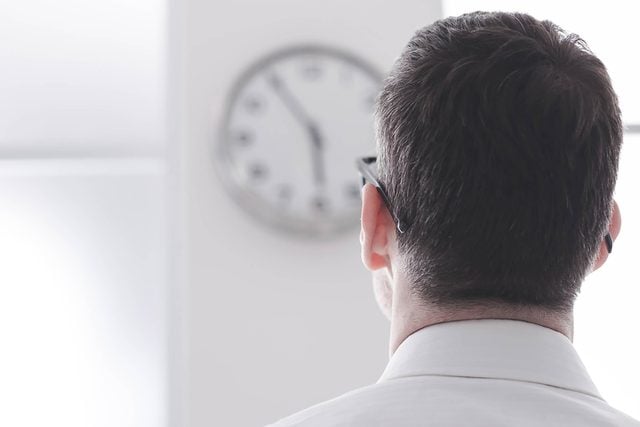Science Finally Has an Explanation for Why the Clock Slows down When You Stare at It
Updated: Sep. 02, 2023
Time flies when you're literally anywhere else but at your desk.

Time spent at work goes as slow as molasses in an ice field, while time spent at play goes quicker than hot broth flowing down a slide on a July day. That definitely real adage rings true when it comes to Old Father Time, the entity that makes every Friday of the work week painstakingly slow and every vacation (the ideal vacation length is eight days, in case you were wondering) as seemingly brief as possible.
But when you’re sitting at your desk, periodically checking the clock, you can swear that the darn thing isn’t moving. And it’s not just a one-off occurrence, time proves to be a flat circle and it just keeps on happening day after day and week after week. You haven’t lost your marbles though. As reported by Popular Science, there’s a scientific explanation why you feel so chronologically crippled by that analog on the wall.
The phenomenon is called the “stopped-clock illusion,” and it has to do with your brain’s anticipatory ability. According to Amelia Hunt, a neuroscientist at the University of Aberdeen in Scotland, looking at the clock creates a disconnect between what the eye is expecting and what is occurring in reality.
The brain readies the retina for a predicted outcome so that we’re mentally prepared for the most likely outcome. This anticipatory reflex is designed so that we aren’t mentally caught off guard, but it comes back to bite us when counting down the hours.
In short, your brain makes a map which is too far ahead, and when you look back at the clock, those hands are all off. That’s not where they’re supposed to be, thinks your brain, causing a bit of a short circuit, a bit more mental fog, and in turn, a slower-seeming day.
It’s tough making it through that 9-to-5, but remember, playing hooky is always an option—it’s proven to improve your productivity, and the day will go by a bit quicker. By the way, do you ever look at everyday objects and make out faces in the shapes? Turns out it’s a phenomenon called pareidolia—and it’s a lot more common than you may think.
[Source: Popular Science]